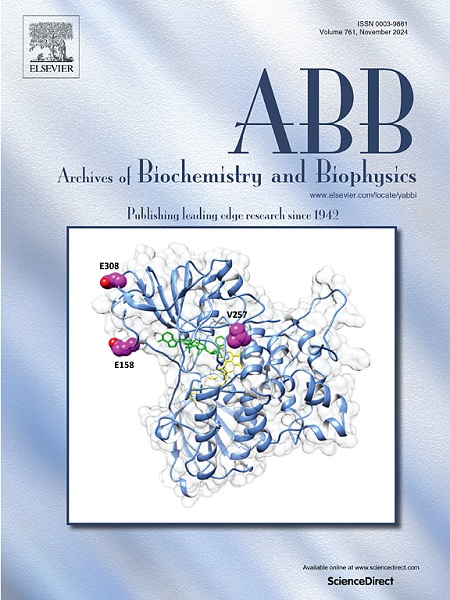天然二苯乙烯类苷对酪氨酸酶的抑制作用:杉木属中乙烯基部分对黑素生成抑制的关键作用
IF 3.8
3区 生物学
Q2 BIOCHEMISTRY & MOLECULAR BIOLOGY
引用次数: 0
摘要
由于紫外线诱导的酪氨酸酶激活和黑色素过量产生引起的皮肤色素沉着是化妆品和皮肤病学应用中一个持续的挑战。虽然白藜芦醇类似物显示出抗黑素的潜力,但其糖基化衍生物的结构-活性关系仍未得到充分研究。在这里,我们研究了食物来源的二苯乙烯苷piceid(白藜芦醇-3- o -β-葡萄糖苷)中的乙烯基部分如何影响酪氨酸酶抑制。我们通过催化加氢还原了乙烯基部分,得到了二氢piceid,并系统地评估了这两种化合物的抗黑素作用。结果表明,杉木酸酯对单酚酶的抑制作用优于双氢杉木酸酯,两种化合物对双酚酶的抑制作用相当。细胞实验显示,在α- msh刺激的B16F10黑色素瘤细胞中,在25 μM时,杉木酸酯能使黑色素生成减少59.2%,而双氢杉木酸酯的活性较弱(减少25%)。MolgpKa分析表明乙烯基片段降低了4 ' -OH pKa (9.7 vs. 9.9),而紫外-可见光谱证实乙烯基片段增强了杉木酸酯(ΔOD: 0.459)比双氢杉木酸酯(ΔOD: 0.233)的铜螯合能力。分子对接发现,piceid中的4′-OH与酪氨酸酶双核铜中心紧密配合,而分子动力学模拟验证了氢键支持这两种化合物与酪氨酸酶的结合。综上所述,本研究确定了膳食中苯乙烯基部分作为酪氨酸酶抑制的重要药效团,从而为开发天然抗色素沉着功能食品或药妆品提供了分子基础。本文章由计算机程序翻译,如有差异,请以英文原文为准。

Tyrosinase inhibition by natural stilbenoid glycosides: Critical role of the vinyl moiety in piceid for melanogenesis suppression
Skin hyperpigmentation due to UV-induced tyrosinase activation and melanin overproduction is an ongoing challenge in cosmetic and dermatological applications. While resveratrol analogues show anti-melanogenic potential, the structure-activity relationships of their glycosylated derivatives remain underexplored. Here, we investigate how the vinyl moiety in the food-derived stilbenoid glycoside piceid (resveratrol-3-O-β-glucoside) affects tyrosinase inhibition. We reduced the vinyl moiety to yield dihydropiceid by catalytic hydrogenation and systematically assessed both compounds for anti-melanogenic effects. As results, piceid exhibited superior monophenolase inhibition over dihydropiceid in enzyme kinetics, while both compounds showed comparable diphenolase inhibition. Cellular assays revealed that piceid reduced melanin production by 59.2 % at 25 μM in α-MSH-stimulated B16F10 melanoma cells, whereas dihydropiceid showed weaker activity (<25 % reduction). MolgpKa analysis indicated that the vinyl moiety lowered the 4′-OH pKa (9.7 vs. 9.9), while UV–vis spectroscopy validated that the vinyl moiety enhanced the copper chelation capacity of piceid (ΔOD: 0.459) over dihydropiceid (ΔOD: 0.233). Molecular docking revealed that 4′-OH in piceid closely coordinated the tyrosinase binuclear copper center, whereas molecular dynamics simulation validated that hydrogen bonding supports the binding of both compounds to tyrosinase. Collectively, this study establishes the vinyl moiety in dietary stilbenoids as a critical pharmacophore for tyrosinase inhibition and thereby provides a molecular basis for developing natural anti-hyperpigmentation functional foods or cosmeceuticals.
求助全文
通过发布文献求助,成功后即可免费获取论文全文。
去求助
来源期刊

Archives of biochemistry and biophysics
生物-生化与分子生物学
CiteScore
7.40
自引率
0.00%
发文量
245
审稿时长
26 days
期刊介绍:
Archives of Biochemistry and Biophysics publishes quality original articles and reviews in the developing areas of biochemistry and biophysics.
Research Areas Include:
• Enzyme and protein structure, function, regulation. Folding, turnover, and post-translational processing
• Biological oxidations, free radical reactions, redox signaling, oxygenases, P450 reactions
• Signal transduction, receptors, membrane transport, intracellular signals. Cellular and integrated metabolism.
 求助内容:
求助内容: 应助结果提醒方式:
应助结果提醒方式:


